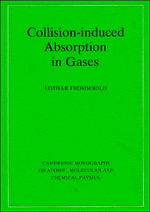7 - Related topics
Published online by Cambridge University Press: 23 September 2009
Summary
In this Chapter, we will briefly look at a number of topics related to collision-induced absorption of infrared radiation in gases. Specifically, in Section 7.1, we consider collision-induced spectra involving electronic transitions in one or more of the interacting molecules. In Section 7.2, we focus on collision-induced light scattering, which is related to collision-induced absorption in the same way that Raman and infrared spectra of ordinary molecules are related. The collision-induced Raman process arises from the fact that the polarizability of interacting atoms/molecules differs from the sum of polarizabilities of the non-interacting species. Closely related to the collision-induced Raman and infrared spectroscopies are the second (and higher) virial coefficients of the dielectric properties of gases, which provide independent measurements of the collision-induced dipole moments, Section 7.3. Finally, we look at the astrophysical and other applications of collision-induced absorption in Sections 7.4 and 7.5.
Collision-induced electronic spectra
Collision-induced electronic spectra have many features in common with rovibrotranslational induced absorption. In this Section, we take a look at the electronic spectra. We start with a historical note on the famous forbidden oxygen absorption bands in the infrared, visible and ultraviolet. We proceed with a brief study of the common features, as well as of the differences, of electronic and rovibrotranslational induced absorption.
- Type
- Chapter
- Information
- Collision-induced Absorption in Gases , pp. 356 - 376Publisher: Cambridge University PressPrint publication year: 1994

